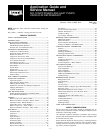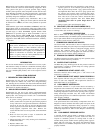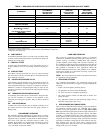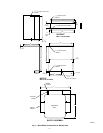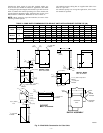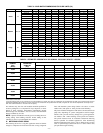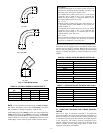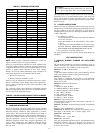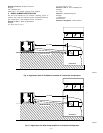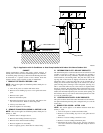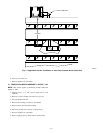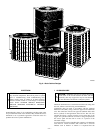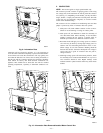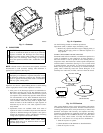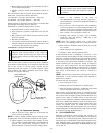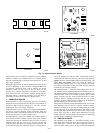
Refrigeration system contains refrigerant under pressure. Extreme
caution should be observed when handling refrigerants. Wear
safety glasses and gloves to prevent personal injury. During
normal system operation, some components are hot and can cause
burns. Rotating fan blades can cause personal injury. Appropriate
safety considerations are posted throughout this manual where
potentially dangerous techniques are addressed.
It is important to recognize safety information. This is the
safety-alert symbol
. When you see this symbol on the unit and
in instructions or manuals, be alert to the potential for personal
injury.
Understand the signal words DANGER, WARNING, and CAU-
TION. These words are used with the safety-alert symbol. DAN-
GER identifies the most serious hazards which will result in severe
personal injury or death. WARNING signifies hazards which
could result in personal injury or death. CAUTION is used to
identify unsafe practices which would result in minor personal
injury or product and property damage. NOTE is used to highlight
suggestions which will result in enhanced installation, reliability,
or operation.
WARNING: Improper installation, adjustment, alter-
ation, service, maintenance, or use can cause explosion,
fire, electrical shock, or other conditions which may
cause personal injury, death, or property damage. Consult
a qualified installer, service agency, or your distributor or
branch for information or assistance. The qualified in-
staller or agency must use factory-authorized kits or
accessories when modifying this product.
INTRODUCTION
This service manual enables a service technician to service, repair,
and maintain a family of similar air conditioners and heat pumps.
It covers standard single-speed products and 2–speed products
only. For variable-speed products, refer to the respective service
manuals.
INSTALLATION GUIDELINE
I. RESIDENTIAL NEW CONSTRUCTION
Specifications for this unit in the residential, new-construction
market require the outdoor unit, indoor unit, refrigerant-tubing
sets, metering device, and filter drier listed in Product Data Sheet
(PDS). DO NOT DEVIATE FROM PDS. Consult unit Installation
Instructions for detailed information.
II. ADD-ON REPLACEMENT (RETROFIT)
Specifications for this unit in the add-on replacement/retrofit
market require change-out of outdoor unit, metering device, and all
capillary-tube coils. Change-out of indoor coil is recommended.
There can be no deviation.
1. If system is being replaced due to compressor electrical
failure, assume acid is in system. If system is being replaced
for any other reason, use approved acid test kit to determine
acid level. If even low levels of acid are detected, install
factory-approved, suction-line filter drier in addition to the
factory-supplied, liquid-line filter drier. Remove the
suction-line filter drier as soon as possible, with a maximum
of 72 hr.
2. Drain oil from low points or traps in suction-line and
evaporator if they were not replaced.
3. Change out indoor coil or verify existing coil is listed in the
Product Data Sheets.
4. Replace outdoor unit.
5. Install liquid-line filter drier.
6. If suction-line filter drier was installed for system clean up,
operate system for 10 hr. Monitor pressure drop across
drier. If pressure drop exceeds 3 psig, replace suction-line
and liquid-line filter driers. Be sure to purge system with
dry nitrogen and evacuate when replacing filter driers.
Continue to monitor pressure drop across suction-line filter
drier. After 10 hr of run time, remove suction-line filter
drier and replace liquid-line filter drier. Never leave
suction-line filter drier in system longer than 72 hr
(actual time).
7. Charge system. (See unit information plate.)
III. SEACOAST (FOR AIR CONDITIONERS ONLY)
Installation of these units in seacoast locations requires the use of
a coastal filter. (See section on cleaning.)
ACCESSORY DESCRIPTIONS
Refer to Table 1 for an Accessory Usage Guide for Air Condi-
tioners and Heat Pumps. See Model-specific product literature for
any kit part number. Refer to the appropriate section below for a
description of each accessory and its use.
I. COMPRESSOR CRANKCASE HEATER
An electric heater which mounts to base of compressor to keep
lubricant warm during off cycles. Improves compressor lubrication
on restart and minimizes chance of refrigerant slugging and oil
pumpout. The crankcase heater may or may not include a
thermostat control. For units equipped with crankcase heaters,
apply power for 24 hr before starting compressor.
II. EVAPORATOR FREEZE THERMOSTAT
An SPST temperature-activated switch stops unit operation when
evaporator reaches freeze-up conditions.
III. WINTER START CONTROL
An SPST delay relay which bypasses the low-pressure switch for
approximately 3 minutes to permit startup for cooling operation
under low-load conditions.
IV. COMPRESSOR START ASSIST—PTC
Solid-state electrical device which gives a ″soft″ boost to the
compressor at each start.
V. COMPRESSOR START ASSIST CAPACITOR/RELAY
Start capacitor and start relay gives ″hard″ boost to compressor
motor at each start. Required with Liquid-Line Solenoid or
hard-shutoff TXV for all equipment.
VI. LOW-AMBIENT CONTROLLER
Low-ambient controller is a cycle-control device activated by a
temperature sensor mounted on a header tube of the outdoor coil.
It is designed to cycle the outdoor fan motor in order to maintain
condensing temperature within normal operating limits (approxi-
mately 100°F high, and 60°F low). The control will maintain
working head pressure at low-ambient temperatures down to 0°F
when properly installed.
VII. MOTORMASTER™ CONTROL
A fan speed-control device activated by a temperature sensor. It is
designed to control condenser fan-motor speed in response to the
saturated, condensing temperature during operation in cooling
mode only. For outdoor temperature down to -20°F, it maintains
condensing temperature at 100°F±10°F. Requires a ball-bearing
fan motor.
VIII. LOW-AMBIENT PRESSURE SWITCH
A long-life pressure switch which is mounted to outdoor unit
service valve. It is designed to cycle the outdoor fan motor in
response to condenser pressure in cooling mode in order to
maintain head pressure within normal operating limits (approxi-
mately 100 psig to 225 psig). The control will maintain working
head pressure at low-ambient temperatures down to 0°F when
properly installed.
—2—



